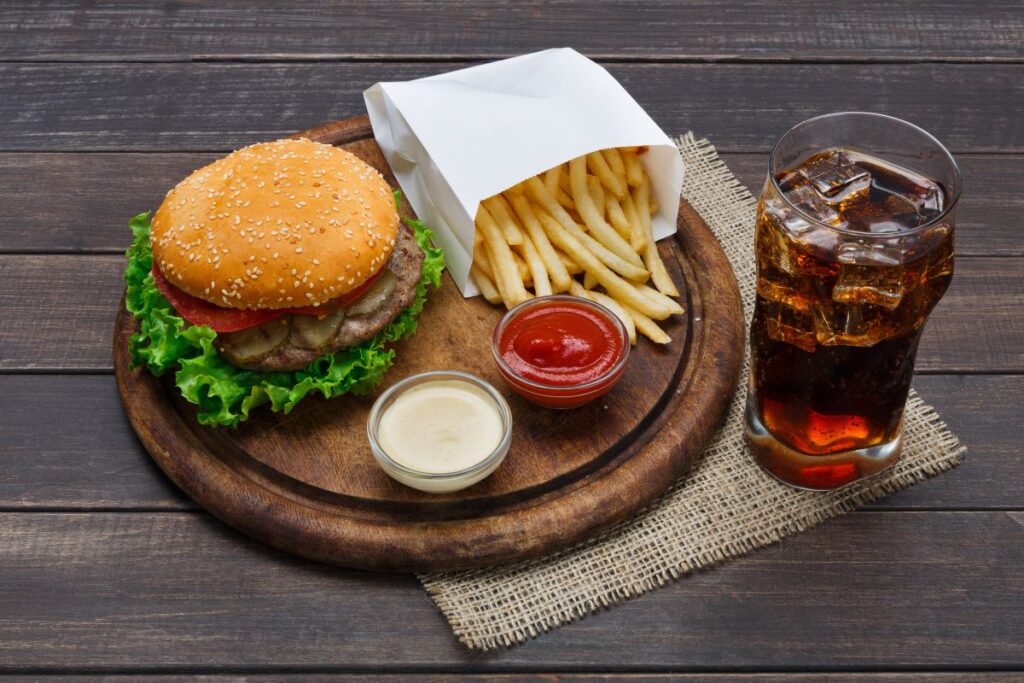Global public health is greatly affected by the growing availability of ultra-processed foods (UPF) and foods rich in fat, sugar, and salt (HFSS). The 2024 Dietary Guidelines for Indians suggest that these items must be consumed in moderation to maintain a healthy lifestyle and reduce the risk of chronic diseases. In this article, we explore the definitions of HFSS and UPF foods, their health implications, and actionable strategies to limit their intake for a healthier, more balanced diet.
What Are HFSS Foods?
HFSS foods are energy-dense items containing high amounts of added fats, sugars, and salt. They often lack essential nutrients like vitamins, minerals, and fibre, making them poor dietary choices despite their widespread availability and appeal.
Examples of HFSS Foods
● Fat-rich foods: Ghee, butter, vanaspati.
● Fried Foods: Samosas, kachori, puri, French fries.
● Sweet Treats: Cakes, biscuits, pastries, desserts.
● Savouries: Packaged snacks, chips.
Levels of HFSS Foods
HFSS foods can be categorised into three levels:
1. Level 1: Small quantities of any one HFSS ingredient (e.g., lightly buttered popcorn).
2. Level 2: Moderate quantities of two HFSS ingredients (e.g., cookies with butter and sugar).
3. Level 3: High quantities of all three HFSS ingredients (e.g., deep-fried desserts).
What Are Ultra-Processed Foods (UPFs)?
UPFs undergo extensive industrial processing, resulting in significant alterations to their natural state. They often include preservatives, sweeteners, colourings, flavour enhancers, and emulsifiers that reduce their nutritional value.
ICMR-NIN Food Categorization by Processing
● Group A: Unprocessed or minimally processed foods (e.g., fresh fruits, vegetables).
● Group B: Moderately processed foods retain most nutrients (e.g., pasteurised milk).
● Group C: Extensively processed foods with additives and low in essential nutrients (e.g., soft drinks, instant noodles).
UPFs fall under Group C, making them unsuitable for regular consumption.
Why minimise HFSS and UPF consumption?
Health Risks of HFSS Foods
1. Nutritional Deficiencies:
High in empty calories but poor in vitamins, minerals, and fibre.
2. Weight gain:
Leads to obesity and related complications.
3. Chronic Diseases:
Regular intake increases the risk of diabetes, hypertension, and heart disease.
4. Cognitive Impairment:
Micronutrient deficiencies can affect cognition, learning, and memory.
Health Risks of UPFs
1. Low Nutrient Density: Lack of bioactive compounds like antioxidants and polyphenols.
2. High Trans Fats: Contribute to heart disease and inflammation.
3. Kidney and Blood Pressure Issues: Excess salt content burdens the kidneys and elevates blood pressure.
4. Cancer Risk: According to some research, using UPF may raise your chance of developing some types of cancer.
Tips to Minimize HFSS and UPF Foods
1. Prioritize Whole Foods
● Choose fresh fruits, vegetables, whole grains, and minimally processed items over packaged snacks.
2. Cook at Home
● Preparing meals at home helps control the amount of fat, sugar, and salt used.
3. Read Food Labels
● Products with a lot of sodium, saturated fats, or added sugar should be avoided.
4. Snack Wisely
● Opt for healthier options like nuts, seeds, roasted chickpeas, or fruit salads.
5. Limit Fast Foods
● Reserve fast food consumption for occasional indulgence, not routine meals.
6. Choose Healthier Cooking Methods
● Bake, grill, or steam foods instead of deep-frying.
7. Stay Hydrated
● Replace sugary drinks with water, coconut water, or herbal teas.
Myths About HFSS and UPFs
Myth 1: “All packaged foods are unhealthy.”
● Fact: Not all packaged foods are HFSS or UPFs. Moderately processed foods like pasteurised milk or whole-grain bread retain most nutrients.
Myth 2: “Homemade fried snacks are healthy.”
● Fact: Even homemade fried items like samosas or puris contain excessive oil, making them high in fat and calories.
Myth 3: “Sugar-free products are always better.”
● Fact: If these substitutes are consumed in excess, these too can have a negative effect on health.
Myth 4: “Fast foods are fine in moderation.”
● Fact: Frequent consumption of even small quantities can accumulate harmful effects over time.
Myth 5: “Only overweight people need to avoid HFSS foods.”
● Fact: HFSS and UPFs harm overall health, irrespective of weight.
FAQs About HFSS and UPFs:
What are the key differences between HFSS and UPFs?
HFSS refers to foods high in fats, sugars, and salts, while UPFs are extensively processed foods often containing additives and low nutrient density.
Are all fried foods considered HFSS?
Yes, most fried foods fall into the HFSS category due to their high fat and calorie content.
How can I identify UPFs on food labels?
Look for extensive ingredient lists with additives like preservatives, flavour enhancers, and emulsifiers.
Are baked goods like biscuits and cakes HFSS?
Yes, these typically contain high amounts of sugar, fat, and refined flour.
What are some healthier alternatives to HFSS snacks?
Roasted chickpeas, fresh fruit, boiled peanuts, or whole-grain crackers with hummus.
How HealthPil Can Help:
At HealthPil, we support your journey to better health by offering:
● Dietary Guidance: Personalised nutrition plans to reduce HFSS and UPF consumption.
● Educational Resources: Tips and tools to identify healthier food options.
● Consultation Services: Expert advice to address dietary challenges and promote a balanced lifestyle.
Disclaimer:
This article is for informational purposes only and does not replace professional medical advice. Consult a healthcare provider for personalised dietary recommendations.
Conclusion:
Reducing HFSS and UPF consumption is essential for maintaining good health and preventing chronic diseases. You can make meaningful dietary improvements by choosing whole, nutrient-dense foods and paying attention to what you eat. You can rely on HealthPil to help you make better decisions for a balanced and sustainable lifestyle.

